DODGE RAM SRT-10 2006 Service Repair Manual
Manufacturer: DODGE, Model Year: 2006, Model line: RAM SRT-10, Model: DODGE RAM SRT-10 2006Pages: 5267, PDF Size: 68.7 MB
Page 4601 of 5267
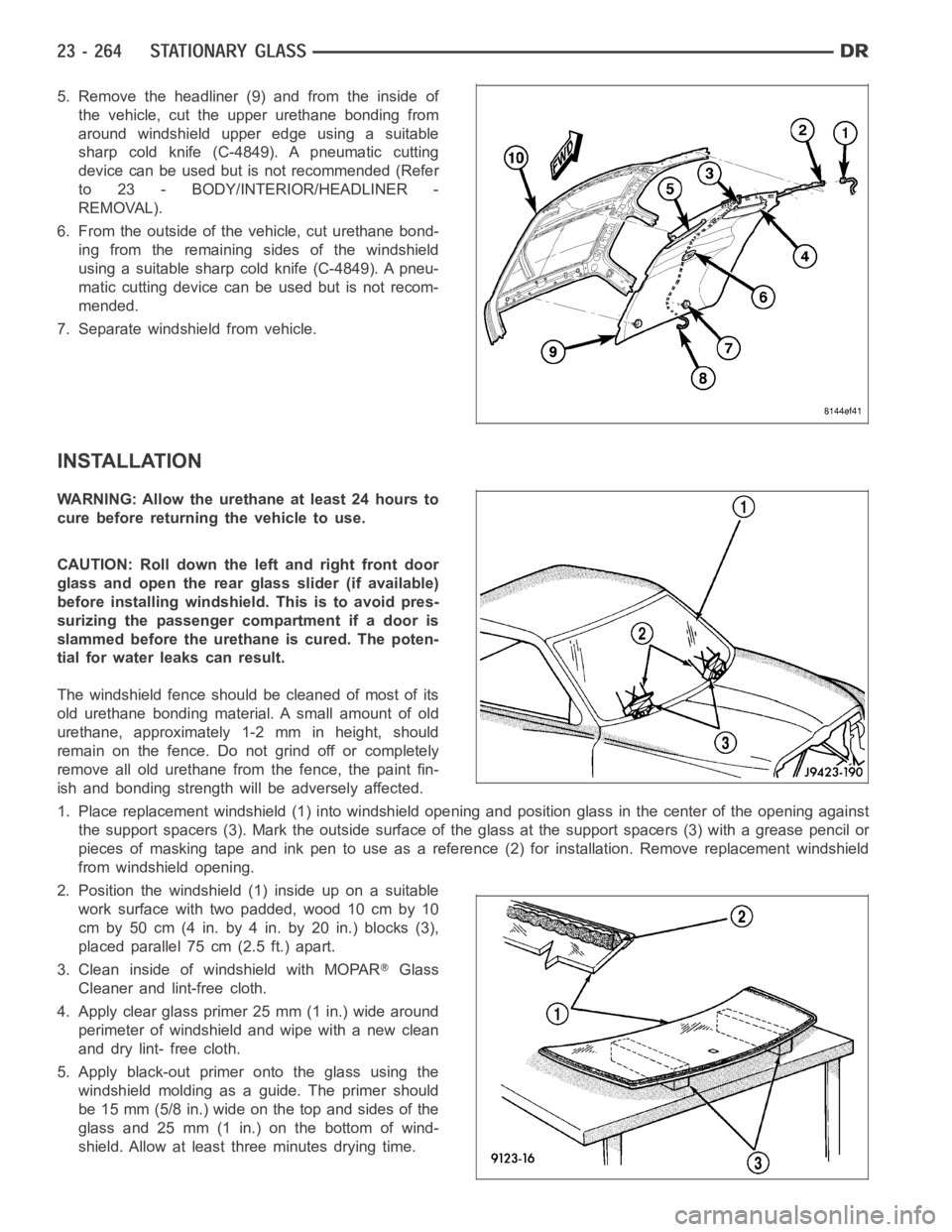
5. Remove the headliner (9) and from the inside of
the vehicle, cut the upper urethane bonding from
around windshield upper edge using a suitable
sharp cold knife (C-4849). A pneumatic cutting
device can be used but is not recommended (Refer
to 23 - BODY/INTERIOR/HEADLINER -
REMOVAL).
6. From the outside of the vehicle, cut urethane bond-
ing from the remaining sides of the windshield
using a suitable sharp cold knife (C-4849). A pneu-
matic cutting device can be used but is not recom-
mended.
7. Separate windshield from vehicle.
INSTALLATION
WARNING: Allow the urethane at least 24 hours to
cure before returning the vehicle to use.
CAUTION: Roll down the left and right front door
glass and open the rear glass slider (if available)
before installing windshield. This is to avoid pres-
surizing the passenger compartment if a door is
slammed before the urethane is cured. The poten-
tial for water leaks can result.
The windshield fence should be cleaned of most of its
old urethane bonding material. A small amount of old
urethane, approximately 1-2 mm in height, should
remain on the fence. Do not grind off or completely
remove all old urethane from the fence, the paint fin-
ish and bonding strength will be adversely affected.
1. Place replacement windshield (1) into windshield opening and positionglass in the center of the opening against
the support spacers (3). Mark the outside surface of the glass at the support spacers (3) with a grease pencil or
pieces of masking tape and ink pen to use as a reference (2) for installation. Remove replacement windshield
from windshield opening.
2. Position the windshield (1) inside up on a suitable
work surface with two padded, wood 10 cm by 10
cm by 50 cm (4 in. by 4 in. by 20 in.) blocks (3),
placed parallel 75 cm (2.5 ft.) apart.
3. Clean inside of windshield with MOPAR
Glass
Cleaner and lint-free cloth.
4. Apply clear glass primer 25 mm (1 in.) wide around
perimeter of windshield and wipe with a new clean
and dry lint- free cloth.
5. Apply black-out primer onto the glass using the
windshield molding as a guide. The primer should
be 15 mm (5/8 in.) wide on the top and sides of the
glass and 25 mm (1 in.) on the bottom of wind-
shield. Allow at least three minutes drying time.
Page 4602 of 5267
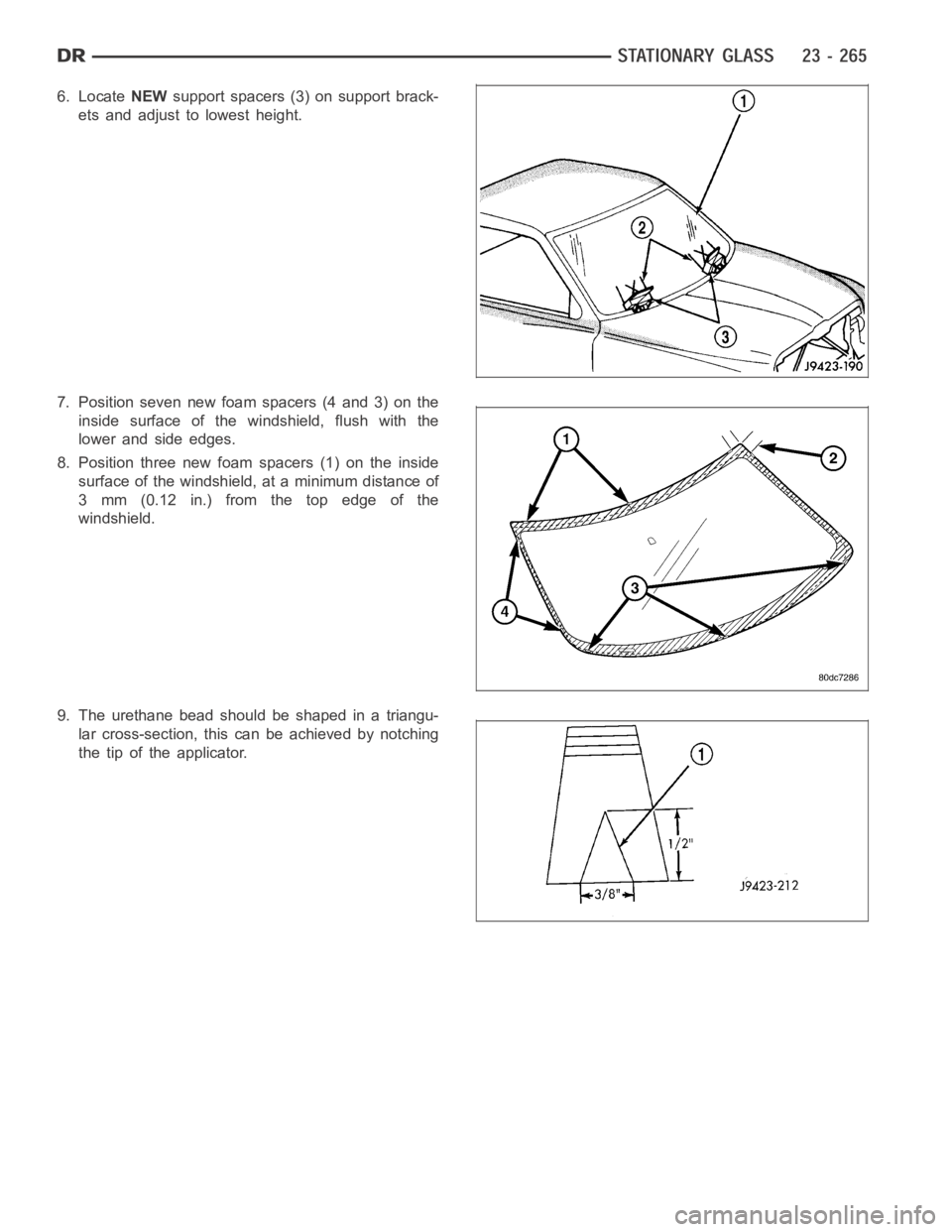
6. LocateNEWsupport spacers (3) on support brack-
ets and adjust to lowest height.
7. Position seven new foam spacers (4 and 3) on the
inside surface of the windshield, flush with the
lower and side edges.
8. Position three new foam spacers (1) on the inside
surface of the windshield, at a minimum distance of
3 mm (0.12 in.) from the top edge of the
windshield.
9. The urethane bead should be shaped in a triangu-
lar cross-section, this canbeachievedbynotching
the tip of the applicator.
Page 4603 of 5267
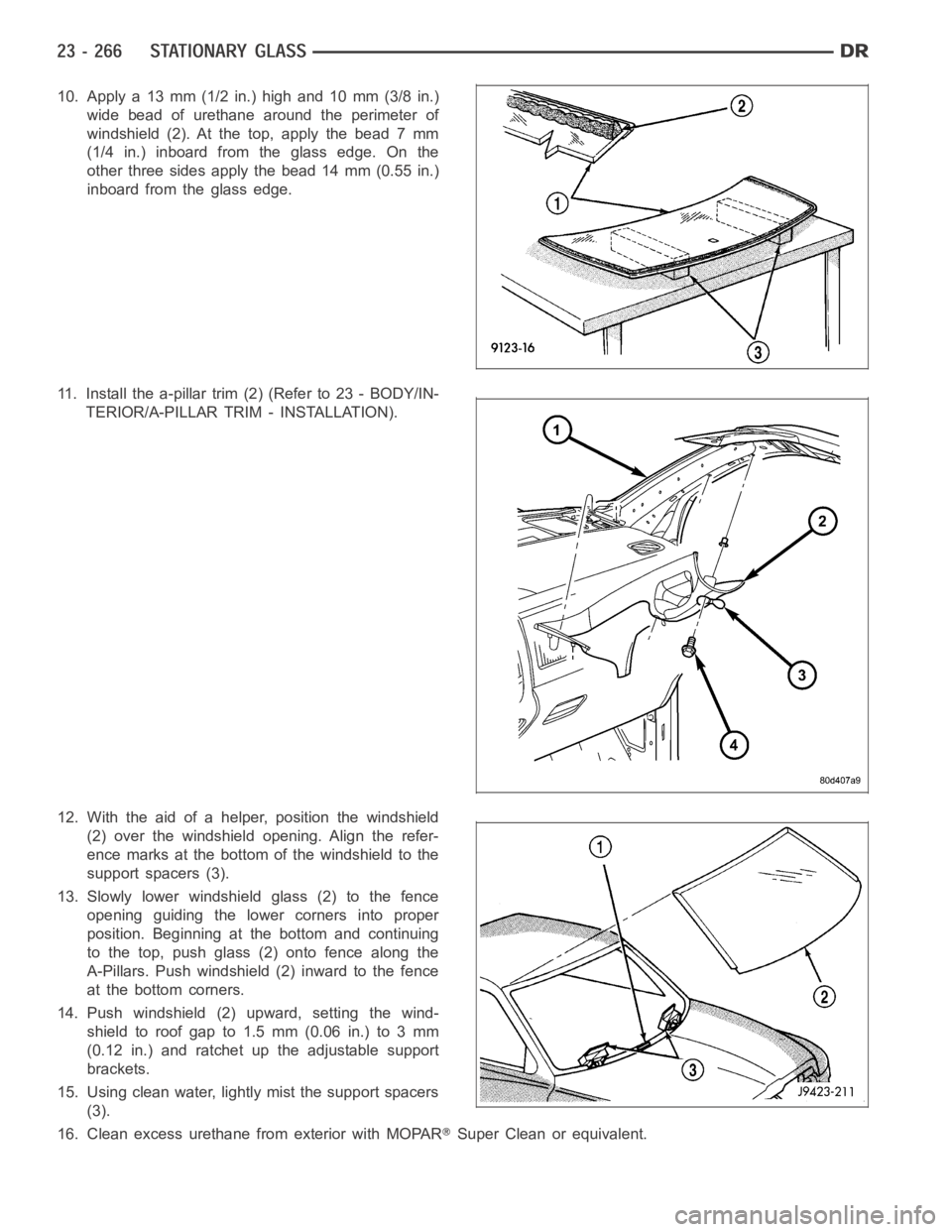
10. Apply a 13 mm (1/2 in.) high and 10 mm (3/8 in.)
wide bead of urethane around the perimeter of
windshield(2).Atthetop,applythebead7mm
(1/4 in.) inboard from the glass edge. On the
other three sides apply the bead 14 mm (0.55 in.)
inboard from the glass edge.
11. Install the a-pillar trim (2) (Refer to 23 - BODY/IN-
TERIOR/A-PILLAR TRIM - INSTALLATION).
12. With the aid of a helper, position the windshield
(2) over the windshield opening. Align the refer-
ence marks at the bottom of the windshield to the
support spacers (3).
13. Slowly lower windshield glass (2) to the fence
opening guiding the lower corners into proper
position. Beginning at the bottom and continuing
to the top, push glass (2) onto fence along the
A-Pillars. Push windshield (2) inward to the fence
at the bottom corners.
14. Push windshield (2) upward, setting the wind-
shieldtoroofgapto1.5mm(0.06in.)to3mm
(0.12 in.) and ratchet up the adjustable support
brackets.
15. Using clean water, lightly mist the support spacers
(3).
16. Clean excess urethane from exterior with MOPAR
Super Clean or equivalent.
Page 4604 of 5267
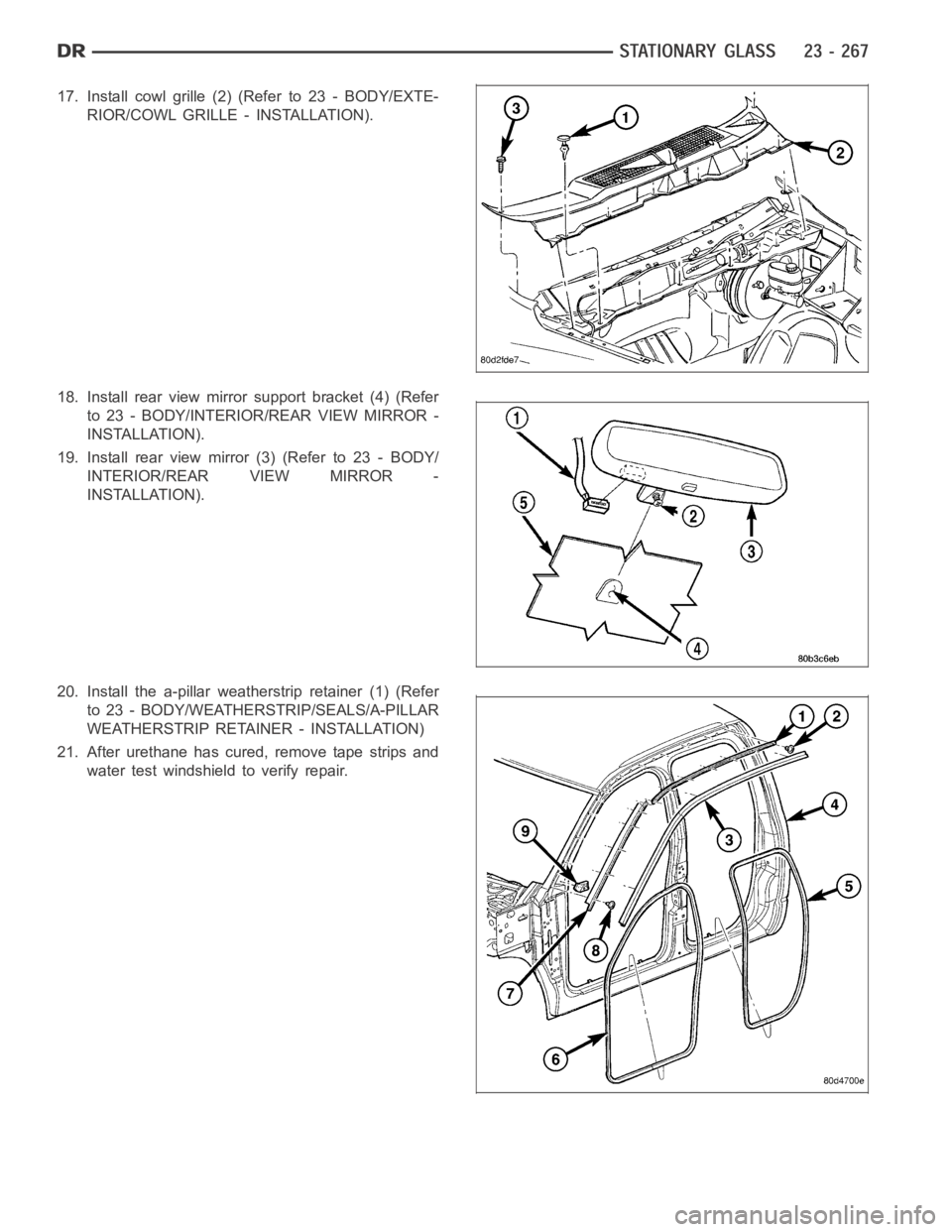
17. Install cowl grille (2) (Refer to 23 - BODY/EXTE-
RIOR/COWL GRILLE - INSTALLATION).
18. Install rear view mirror support bracket (4) (Refer
to 23 - BODY/INTERIOR/REAR VIEW MIRROR -
INSTALLATION).
19. Install rear view mirror (3) (Refer to 23 - BODY/
INTERIOR/REAR VIEW MIRROR -
INSTALLATION).
20. Install the a-pillar weatherstrip retainer (1) (Refer
to 23 - BODY/WEATHERSTRIP/SEALS/A-PILLAR
WEATHERSTRIP RETAINER - INSTALLATION)
21. After urethane has cured, remove tape strips and
water test windshield to verify repair.
Page 4605 of 5267

BACKLITE VENT GLASS - REGULATOR
REMOVAL
1. Disconnect and isolate the battery negative cable.
2. Remove the rear seats (Refer to 23 - BODY/SEATS/SEAT - REMOVAL).
3. Remove the rear cab back panel (Refer to 23 - BODY/INTERIOR/REAR CAB BACKPANEL TRIM - REMOVAL).
4. Remove the two mounting bolts (1).
5. Disconnect the electrical connector to the power
motor.
6. Separate the cable housings from the glass track
(1).
7. Disconnect the cable ends from the vent glass (2).
8. Separate the support clips (5) and remove the reg-
ulator assembly (3).
Page 4606 of 5267
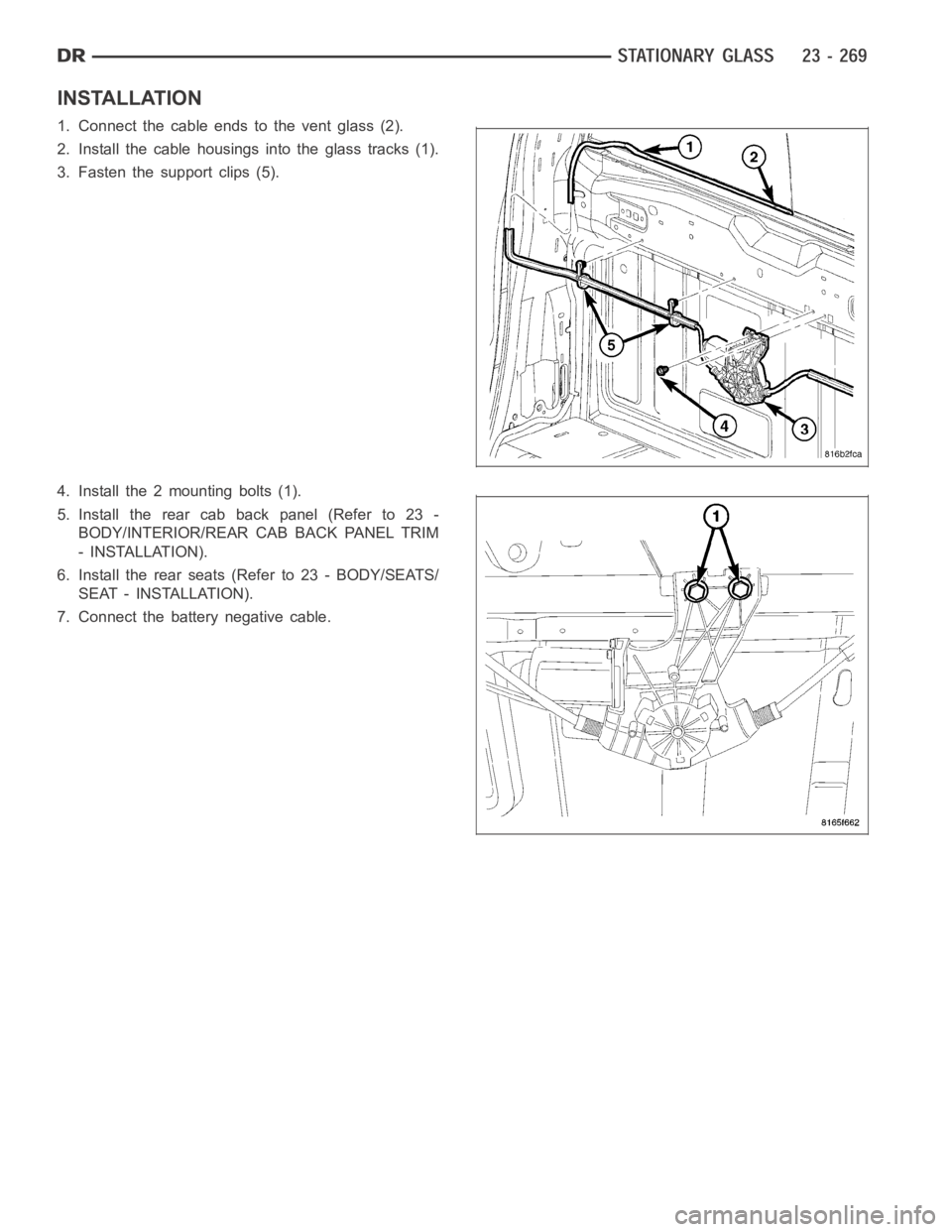
INSTALLATION
1. Connect the cable ends to the vent glass (2).
2. Install the cable housings into the glass tracks (1).
3. Fasten the support clips (5).
4. Install the 2 mounting bolts (1).
5. Install the rear cab back panel (Refer to 23 -
BODY/INTERIOR/REAR CAB BACK PANEL TRIM
- INSTALLATION).
6. Install the rear seats (Refer to 23 - BODY/SEATS/
SEAT - INSTALLATION).
7. Connect the battery negative cable.
Page 4607 of 5267

page page
SUNROOF - SERVICE INFORMATION
DESCRIPTION ............................... 271
OPERATION ................................. 272
DIAGNOSIS AND TESTING
POWER TOP - SUNROOF .................. 273
SUNROOF ................................ 273
ASSEMBLY-MODULE
REMOVAL ................................... 276
INSTALLATION .............................. 278
CHANNEL-DRAIN
REMOVAL ................................... 280
INSTALLATION .............................. 281
COVER-GUIDE MECHANISM
REMOVAL ................................... 282
INSTALLATION .............................. 283
DEFLECTOR-WIND
REMOVAL ................................... 284
INSTALLATION .............................. 285
GLASS
REMOVAL ................................... 286INSTALLATION .............................. 287
ADJUSTMENTS
ADJUSTMENT ............................. 288
GUIDE-SUNROOF GLASS
REMOVAL ................................... 289
INSTALLATION .............................. 291
HOSE-DRAIN
REMOVAL ................................... 293
INSTALLATION .............................. 294
MOTOR
DESCRIPTION ............................... 295
SUNSHADE
REMOVAL ................................... 296
INSTALLATION .............................. 297
SWITCH-SUNROOF
DESCRIPTION ............................... 298
TRIM RING
REMOVAL ................................... 299
INSTALLATION .............................. 299
Page 4608 of 5267

SUNROOF - SERVICE INFORMATION
DESCRIPTION
Parts List
EXPLODED VIEW
Page 4609 of 5267

1 - MECHANISM COVERS (2) 10 - MOTOR FASTENERS (3)
2 - RIGHT HAND GLASS GUIDE 11 - SUNROOF MOTOR/MODULE ASSEMBLY
3 - GLASS FASTENERS (4) 12 - ALIGNMENT HOLE
4 - GLASS ASSEMBLY 13 - TRIM RING
5 - DRAIN CHANNEL 14 - ASSEMBLY FASTENERS (8)
6 - SUNSHADE 15 - ALIGNMENT HOLE
7 - LEFT SUNROOF GLASS GUIDE 16 - WIND DEFLECTOR
8 - WIRE HARNESS 17 - GLASS GUIDE FOOT
9 - SUNROOF ASSEMBLY 18 - WIND DEFLECTOR STRAP SCREWS (2)
The power sunroof system allows the sunroof to be opened, closed or placed in the vent position electrically by
actuating a switch in the overhead console. The sunroof system receives battery feed through a fuse in the Power
Distribution Center (PDC). The sunroof will operate normally with the keyin any position while the Accessory Delay
system is active.
The sunroof glass panel tilts upward at the rear for ventilation and slidesrearward under the roof when open. The
panel seals flush with the roof in the closed position to eliminate wind noise. The sunroof includes a manual-sliding
sunshade to cover the deep-tinted glass panel.
In addition to the standard power sunroof operation, this vehicle offers several additional features. There is an
express (one-touch) opening and closing feature as well as Excessive Force Limitation (EFL). The EFL function
detects obstacles trapped between the glass and the vehicle roof during a closing motion. Upon sensing an obstacle
the EFL function will reverse direction of the glass to allow removal of theobstacle.
The main components of thepower sunroof system are:
The motor/module assembly
The power sunroof glass and frame assembly
The power sunroof switch
The manual-sliding sunshade
OPERATION
This vehicle has a vent, tilt and slide power sunroof system with express (one-touch) open and closing feature. The
sunroof system receives constant battery feed through a fuse in the Power Distribution Center (PDC). The sunroof
will operate normally with the key in any position while the Accessory Delay system is active. If the sunroof is mov-
ing when the key is turned to the START position (crank engine), all motionsstop until the key is released, then the
previously requested sunroof motion will resume. The sunroof will also complete a requested motion if the Acces-
sory Delay system goes inactivewhile the motion is in progress.
A combination push-button and rocker switch module mounted in the overhead console controls sunroof operation.
The sunroof switch is a rocker design with a push button in the center of the two halves of the rocker. Pressing the
rocker towards the front of the car commands the sunroof closed. Pressing the rocker towards the rear of the car
commands the sunroof open. Pressing the center push button commands the sunroof up into the vent position
(Rear of sunroof glass raises above the vehicle roof with glass still covering the sunroof opening). All switch com-
mands operate with the glass startingin any position. (Refer to 8 - ELECTRICAL/POWER TOP/SWITCH - OPER-
ATION) for additional information.
An electronic control system, integralto the motor/module assembly, provides the express open and close functions.
Pressing the
openorcloseend of the rocker switch moves the sunroof glass panel to the full open or fullclosed
position, respectively. During express closing, anytime an obstacle is detected in the way of the glass, the motor will
stop and reverse travel to avoid pinching an occupant’s finger, ice in the track, etc. This function is called Excessive
Force Limitation (EFL). There are two methods of overriding the EFL function.
1. When three EFL events occur without the glass being allowed to fully close, the next close attempt will only
move while the close switch is continuously actuated. This allows the sunrooftobeforcedclosedifmultipleclose
attempts fail.
2. If the sunroof close switch is continuously actuated during an EFL event, through the reversal, and during a two
second wait time, then continuing to hold the close switch will cause the roof to move towards close with the EFL
protection disabled. This allows the sunroof to be forced closed if it is known that a reversal will occur.
While in EFL override, the closing motion will cease if the sunroof switch is released at any time.
Page 4610 of 5267
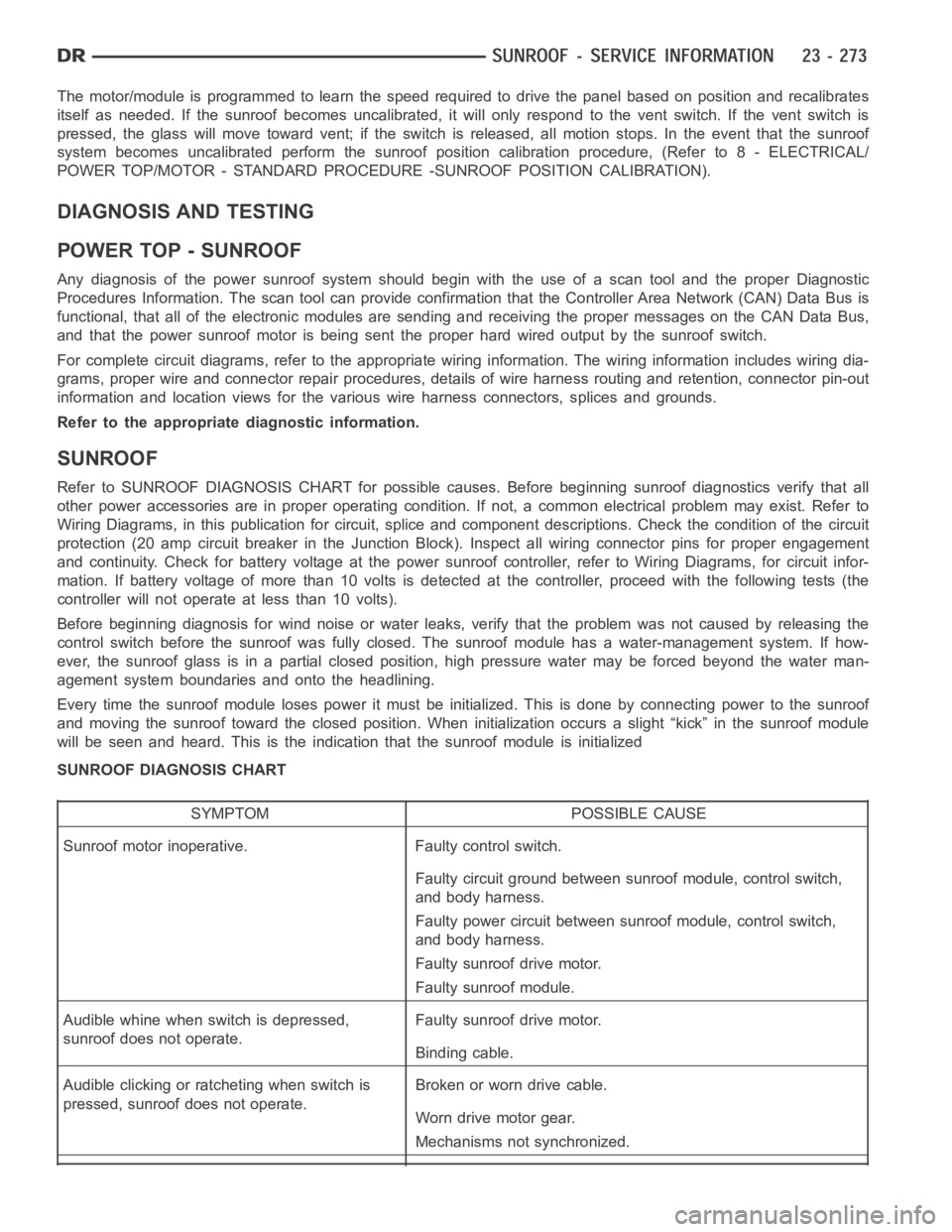
The motor/module is programmed to learn the speed required to drive the panel based on position and recalibrates
itself as needed. If the sunroof becomes uncalibrated, it will only respond to the vent switch. If the vent switch is
pressed, the glass will move toward vent; if the switch is released, all motion stops. In the event that the sunroof
system becomes uncalibrated performthe sunroof position calibration procedure, (Refer to 8 - ELECTRICAL/
POWER TOP/MOTOR - STANDARD PROCEDURE -SUNROOF POSITION CALIBRATION).
DIAGNOSIS AND TESTING
POWER TOP - SUNROOF
Any diagnosis of the power sunroof system should begin with the use of a scantool and the proper Diagnostic
Procedures Information. The scan tool can provide confirmation that the Controller Area Network (CAN) Data Bus is
functional, that all of the electronic modules are sending and receiving the proper messages on the CAN Data Bus,
and that the power sunroof motor is being sent the proper hard wired output by the sunroof switch.
For complete circuit diagrams, refer to the appropriate wiring information. The wiring information includes wiring dia-
grams, proper wire and connector repair procedures, details of wire harness routing and retention, connector pin-out
information and location views for the various wire harness connectors, splices and grounds.
Refer to the appropriate diagnostic information.
SUNROOF
Refer to SUNROOF DIAGNOSIS CHART for possible causes. Before beginning sunroof diagnostics verify that all
other power accessories are in proper operating condition. If not, a common electrical problem may exist. Refer to
Wiring Diagrams, in this publication for circuit, splice and component descriptions. Check the condition of the circuit
protection (20 amp circuit breaker in the Junction Block). Inspect all wiring connector pins for proper engagement
and continuity. Check for battery voltage at the power sunroof controller, refer to Wiring Diagrams, for circuit infor-
mation. If battery voltage of more than 10 volts is detected at the controller, proceed with the following tests (the
controller will not operate at less than 10 volts).
Before beginning diagnosis for wind noise or water leaks, verify that the problem was not caused by releasing the
control switch before the sunroof was fully closed. The sunroof module hasa water-management system. If how-
ever, the sunroof glass is in a partial closed position, high pressure water may be forced beyond the water man-
agement system boundariesand onto the headlining.
Every time the sunroof module loses power it must be initialized. This is done by connecting power to the sunroof
and moving the sunroof toward the closed position. When initialization occurs a slight “kick” in the sunroof module
will be seen and heard. This is the indication that the sunroof module is initialized
SUNROOF DIAGNOSIS CHART
SYMPTOM POSSIBLE CAUSE
Sunroof motor inoperative. Faulty control switch.
Faulty circuit ground between sunroof module, control switch,
and body harness.
Faulty power circuit between sunroof module, control switch,
and body harness.
Faulty sunroof drive motor.
Faulty sunroof module.
Audible whine when switch is depressed,
sunroof does not operate.Faulty sunroof drive motor.
Binding cable.
Audible clicking or ratcheting when switch is
pressed, sunroof does not operate.Broken or worn drive cable.
Worn drive motor gear.
Mechanisms not synchronized.